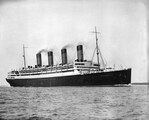RMS Aquitania
 RMS Aquitania on her maiden voyage in New York Harbor, 5 June 1914.
| |
| History | |
|---|---|
| Name | Aquitania |
| Namesake | Aquitania (Roman province in France)[3] |
| Owner |
|
| Operator | Cunard Line |
| Port of registry | |
| Route | Southampton-New York (1914) (1920–1939) (1945–1948) (1945–1950) Southampton-Halifax (1948–1950) |
| Ordered | 8 December 1910[1] |
| Builder | John Brown & Company, Clydebank, Scotland[1] |
| Yard number | 409[2] |
| Laid down | December 1910 |
| Launched | 21 April 1913[1] |
| Christened | 21 April 1913 by the Countess of Derby |
| Completed | 1914 |
| Acquired | 24 May 1914 |
| Maiden voyage | 30 May–5 June 1914, from Liverpool to New York[1] |
| In service | 1914–1950 (36 years) |
| Out of service | 21 February 1950 |
| Identification | Wireless call sign: MSU (by 1915) |
| Fate | |
| General characteristics | |
| Type | Ocean liner |
| Tonnage | 45,647 GRT, 21,993 NRT[4] |
| Displacement | 49,430 tons |
| Length | 901 ft (274.6 m)[4] |
| Beam | 97 ft (29.6 m)[4] |
| Height | 164 ft (50.0 m) from bottom to top |
| Draught | 36 ft (11.0 m)[1] |
| Depth | 92.5 ft (28.2 m) |
| Decks | 10 |
| Installed power |
|
| Propulsion | Four shafts[4] |
| Speed | |
| Capacity | |
| Crew | 972[1] |
| Notes |
|
RMS Aquitania was an
Returned to transatlantic passenger service in 1920, she operated alongside Mauretania and the Berengaria. Considered during this period of time as one of the most attractive ships, Aquitania earned the nickname "the Ship Beautiful" from her passengers.[4] She continued in service after the merger of Cunard Line with White Star Line in 1934. The company planned to retire her and replace her with RMS Queen Elizabeth in 1940.
However, the outbreak of the Second World War allowed the ship to remain in service for ten more years. During the war and until 1947, she served as a troop transport. She was used in particular to take home Canadian soldiers from Europe. After the war, she transported migrants to Canada before the Board of Trade found her unfit for further commercial service. Aquitania was retired from service in 1949 and was sold for scrapping the following year. Having served as a passenger ship for 36 years, Aquitania ended her career as the longest-serving Cunard vessel, a record which stood for six years until overtaken by
Conception

The origins of Aquitania lay in the rivalry between the
Design, construction and launch

Aquitania was designed by Cunard naval architect

In the wake of the
Aquitania was
Technical aspects

Aquitania was the first Cunard liner to have a length in excess of 900 feet (270 m).[10] Unlike some four-funneled ships, such as White Star Line's Olympic-class ocean liners, Aquitania did not have a dummy funnel; each funnel was utilised in venting smoke from the ship's boilers.[17][18]
Steam was provided by twenty-one forced-draft, double-ended Scotch boilers, having eight furnaces each, that were 22 feet (6.7 m) long with diameter of 17 feet 8 inches (5.4 m) arranged in four boiler rooms.[19] Each boiler room had seven ash expellers with pump capacity of approximately 4,500 tons per hour that could also be used as emergency bilge pumps.[19]
Steam drove
The electrical plant, located on G deck below the waterline, consisted of four 400 kW British Westinghouse generator sets generating 225 volt direct current, with emergency power provided by a diesel driven 30 kW generator up on the promenade deck.[21] Power was provided for about 10,000 lamps and about 180 electric motors.[21] She also had brass triple chambered 3 chime steam whistles on the 1st funnel and 2nd funnel.
Interior and design

In 1914, Aquitania had the capacity to carry 3,220 passengers (618 First Class, 614 Second Class, 2,004 Third Class). After a refit in 1926, the figure was reduced to 610 in first class, 950 in second class, and 640 in tourist class. Although the original specification mentioned a capacity of 972 crew members, the ship sometimes carried around 1,100.[9]
Although Aquitania lacked the lean, yacht-like appearance of running mates Mauretania and Lusitania, the greater length and wider beam allowed for grander and more spacious public rooms. Her public spaces were designed by the British architect

In the years prior to the First World War, Mewès was charged with the decoration of HAPAG's trio of giant new ships,

The second class had a dining room, several lounges, a smoking room, a veranda café, and a gymnasium; many being unique facilities for this class on British ocean liners of the time. The third class had several common areas, a promenade, and three shared bathrooms.[22] The cabins offered great comfort. The first class included eight luxury suites, named after famous painters. A large number of first-class cabins had bathrooms, although not all did. The second-class cabins were larger than average, most being capable of accommodating three people as opposed to the standard four. Her Third Class accommodations were a great expansion in facilities compared to her running mates. While most Cunard liners had their Third Class areas confined forward, aboard Aquitania such spaces spanned the full length of the ship, and included several large open areas, three large dining rooms and both open and enclosed promenades.[23]
Over her thirty-five years career, her facilities changed. Examples of this were the addition of a cinema during her refit from 1932 to 1933[24] and the reorganisation of the tourist class during the 1920s for giving greater comfort to poor passengers.[25]
Early career and World War I
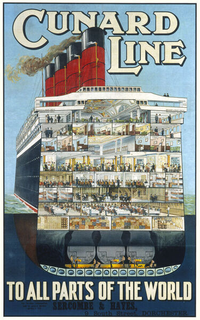
Aquitania's maiden voyage was under the command of Captain William Turner on 30 May 1914 with arrival in New York on 5 June.[1][15] The voyage and arrival in New York received great attention.[26] Fifteen days earlier, the German liner SS Vaterland, being the largest ship in the world at the time, was put into service. In the eye of the press, this maiden voyage was a matter of national prestige.[27] However, this event was overshadowed by the sinking of RMS Empress of Ireland in Quebec the previous day with over a thousand drowned.[28] However, no passenger cancelled their voyage aboard the Aquitania, despite the strong emotion aroused by this sinking.[16] During her maiden voyage, the ship carried around 1,055 passengers, which was about a third of her total capacity. This was because a superstition pushed some people away from travelling on a ship's maiden voyage.[citation needed] The crossing fully satisfied the crew and the company. Average speed for the voyage, a distance of 3,181 nautical miles (5,891 km; 3,661 mi) measured from Liverpool to the Ambrose Channel lightship, was 23.1 knots (42.8 km/h; 26.6 mph),[15] taking into account a five-hour stop due to fog and the proximity of icebergs.[29] The ship briefly managed to exceed 25 knots. Also, her coal consumption was significantly lower than that of Lusitania and Mauretania. Many passengers enjoyed the voyage. On the return trip, the success was renewed; she carried a total of 2,649 passengers, which was a record for a British liner leaving New York.[30]

Upon arrival at her home port, she underwent minor modifications, which took into account observations made during the two first crossings (this was typical for a liner after its first round trip).[30] Two more round trips took place in the second half of June and the whole of July of that year. Her architect Leonard Peskett was on board during those trips to note any defect and room for improvement. In total, 11,208 passengers travelled on the ship during her first six crossings.Chirnside 2008, p. 26 Her career was abruptly interrupted by the outbreak of World War I, which removed her from passenger service for six years.[31][32]
In June 1914 Archduke Franz Ferdinand of Austria was assassinated, and the world was soon plunged into World War I. Aquitania was converted into an armed merchant cruiser on 5 August 1914, for which provision had been made in her design. On 8 August, having been rid of decorative elements and armed with guns, she was sent on patrol. On 22 August, she collided with a liner named Canadian. Shortly after, the Admiralty found that large liners were too expensive to operate as cruisers. On 30 September, she was repaired, disarmed, and returned to Cunard Line.[33][4]

After being idle for a time, in the spring of 1915 she was recalled by the Admiralty and converted into a
After the end of the war, in December 1918, Aquitania was dismissed from military service. She collided with the British cargo ship Lord Dufferin at New York in the United States on 28 February 1919. Lord Dufferin sank and Aquitania rescued her crew.[37] Lord Dufferin was later refloated and beached.[38]
Interwar career
In June 1919, Aquitania ran a Cunard "austerity service" between
1920s

Aquitania resumed her commercial service on 17 July 1920, leaving from Liverpool with 2,433 passengers on board. The crossing was a success; the ship maintained good speed while showing that now being oil-fueled was much cheaper than coal-fueled propulsion.[41] The ship's arrival in New York Harbor was filmed as part of the pioneering 1921 documentary Manhatta, in which she is seen being pushed to her destination by tugboats. The months that followed were just as promising, despite a stewards' strike in May 1921.[42] At the beginning of the decade, Aquitania was the only large liner in the service of Cunard Line as the Mauretania was undergoing repair after a fire. The year 1921 was thus an exceptional year for her; she crossed the Atlantic 30 times (15 round trips) and broke a record by transporting a total of 60,587 passengers that year (including 26,331 in third class), averaging more than 2,000 passengers per crossing.[43] In the following year, the Mauretania rejoined her in Cunard service. Aquitania operated in service with the Mauretania and Berengaria (formerly the German liner Imperator) in a trio known as "The Big Three."[4][44]
In 1924, a new restriction on immigration was passed in the United States, causing the number of third-class passengers to decline significantly. From more than 26,000 third-class passengers transported by Aquitania in 1921, the figure fell to about 8,200 third-class passengers in 1925. The number of crew was thus reduced to around 850 people from the original 1,200.[44] The third class was no longer the key to the profitability of the liner, and so the company had to adapt. The third-class gradually became a tourist class, which offered decent service at a low price. In 1926, the ship underwent a major overhaul, which reduced the passenger capacity from around 3,300 to around 2,200.[45]
Still, the Cunard Line benefited from prohibition in the United States, which started in 1919. American liners were legally part of the territory of the United States, and thus alcoholic beverages could not be served on them. Passengers who wanted to drink therefore travelled on British liners in order to do so.[46] Aquitania enjoyed great success, making much profit for her company. In 1929, she underwent a major refit. A bathroom was added to many first-class cabins, and the tourist class was renovated. While new competitors, such as the German liner SS Bremen, entered service, Aquitania remained particularly popular after fifteen years of service.[47]
Crisis of 1929 and its consequences
Following the
To keep the ship up to date, she underwent a refit, which added a cinema, between 1932 and 1933. At the same time, in order to modernise its fleet, the company ordered the Queen Mary. The Great Depression, however, prevented the company from being able to fully finance the construction, and the company merged with its rival, the White Star Line, in 1934 in order to do so. The Queen Mary entered service in 1936.[51] Author C. R. Bonsor writing in 1963 states, "from 1936 on it became necessary to squeeze the maximum speed out of Aquitania in order to make her a suitable running mate for Queen Mary thus 24 knot passages became regular".[52]
Aquitania ran aground in the
World War II service
Aquitania, with a normal troop capacity of 7,400, was among the select group of large, fast former passenger ships capable of sailing independently without escort transporting large numbers of troops that were assigned worldwide as needed.[56] These ships, often termed "Monsters" until London requested the term be dropped, were Aquitania, Queen Mary, Queen Elizabeth, Mauretania (II), Île de France and Nieuw Amsterdam with "lesser monsters" being other large ex-liners capable of independent sailing with large troop capacity that accounted for much of the troop capacity and deployment, particularly in the early days of the war.[57][58]
Plans to replace Aquitania with the newer Queen Elizabeth in 1940 had been forestalled by outbreak of World War II in 1939.[4] On 16 September 1939 Aquitania, awaiting initial refit as a troop ship, was at pier 90 in New York along with Queen Mary while nearby, at pier 88, were the French ships Île de France and Normandie.[1][4] She returned to Southampton and was requisitioned on 18 November.[59]
Aquitania's initial troop transport operation was taking Canadian troops to Scotland, Convoy TC1 in company with
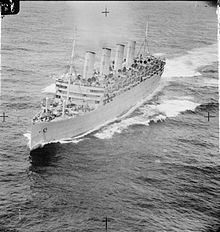
Now repainted battleship grey, in November 1941 Aquitania was in the British colony of
December saw the outbreak of war in the Pacific, then Japanese advances throughout Southeast Asia and toward Australia, necessitating the redeployment of defensive forces.
With the United States in the war, Aquitania (then with a troop capacity of 4,500) had been scheduled for transport duties from the United States to Australia in February, but necessary repairs delayed that. Because her deep draft was hazardous in Australian and intermediate ports in the Pacific Islands,[69] she spent March and April 1942 transporting troops from the west coast of the U.S. to Hawaii.[57][70] Then Aquitania was temporarily transferred from Pacific duties to support the movement of troops from the United States to Britain, sailing 30 April from New York in a large convoy that transported some 19,000 troops.[71]
On 12 May 1942 Aquitania loaded troops at Gourock destined for the war in the Middle East, departing in convoy WS19P on 1 June with destroyers and heavy weather, she broke off independently on 7 June due to her greater speed with designation WS19Q.
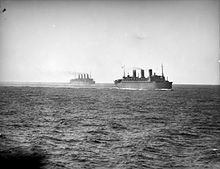
As part of the major redeployment of Australian troops from North Africa to the defence of Australia and start of offensive operations in the
By the buildup for the invasion of Europe in 1944 troop deployments to Britain depended heavily on Aquitania and the other "Monsters" and no allowance could be made for interruption of their service for other transport requirements.[76]
Wartime embarkation at New York is described in some detail in the description of the departure of the Special Navy Advance Group 56 (SNAG 56) that was to become Navy Base Hospital Number 12 at the
In eight years of military work, Aquitania sailed more than 500,000 miles, and carried nearly 400,000 soldiers,[1][78] to and from places as far afield as New Zealand, Australia, the South Pacific, Greece and the Indian Ocean.[79] Cunard historian Michael Gallagher said: "Wartime Prime Minister Winston Churchill credited Aquitania, with Queen Mary and Queen Elizabeth, for shortening World War II in Europe by a year".
Postwar service and retirement

After completing troopship service, the vessel was handed back to Cunard-White Star in 1948. She underwent a refit for passenger service. She was then used to transport war brides and their children to Canada under charter from the Canadian government. This final service created a special fondness for Aquitania in Halifax, Nova Scotia, the port of disembarkation for these immigration voyages.[80][4]
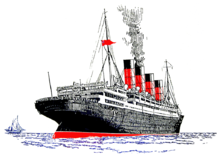
Aquitania sailed on her last commercial voyage from Halifax to Southampton, from November 24 1949 to 1 December 1949. After serving her purpose, the old Aquitania was taken out of service in December 1949, when the ship's Board of Trade certificate was not renewed as the condition of the ship had deteriorated, and it would have been cost-prohibitive to be brought up to new safety standards, namely fire code regulations. The decks leaked in foul weather, the bulkheads and funnels were corroded to a point that one could stick their finger through them. A long-standing rumor was made that during a corporate luncheon held on the ship, a piano had fallen through the roof of one of the dining rooms from the deck above. This has been proven to be false.[4][81]

After its last voyage in February 1950 from Southampton to Faslane, the vessel was sold to British Iron and Steel Corporation for scrap for £125,000 at Faslane in Scotland.[1] Dismantling took more than a year to complete and was finally finished in November 1951.[81] This ended a career which included steaming 3 million miles over 450 round voyages. Aquitania carried 1.2 million passengers through an active sea career that spanned nearly 36 years, making her the longest-serving Express Liner of the 20th century. Aquitania was the only major liner and largest vessel to serve in and survive both World Wars. She was also the last four-funnelled passenger ship to be scrapped.[78] The ship's wheel and a detailed scale model of Aquitania may be seen in the Cunard exhibit at the Maritime Museum of the Atlantic in Halifax.
Maritime author N. R. P. Bonsor wrote of Aquitania in 1963: "Cunard had recovered possession of their veteran in 1948 but she was not worth reconditioning. In 35 years of service Aquitania had sailed more than 3 million miles and apart from one or two early
Gallery
-
A naval drawing of RMS Aquitania in her original 1914 appearance (starboard profile).
-
Aquitania's First Class Dining Room.
-
Aquitania's First Class Smoking Room.
-
Aquitania's First Class Staircase.
-
Aquitania's First Class Swimming Pool.
-
Aquitania's First Class Longue.
-
RMS Aquitania, stern view. This photograph was taken in early May 1914, shortly before the ship's maiden voyage later that month.
-
RMS Aquitania as built in 1914.
-
HMHS Aquitania seen in 1916 as a hospital ship duringThe Great War.
-
A drawing of HMT Aquitania in her own unique dazzle scheme duringWorld War I.
-
RMS Aquitania photographed on February 22 1919. She is still painted in her uniqueWW1dazzle scheme.
-
RMS Aquitania seen with one of her running mates, RMS Mauretania (right in front), and the White Star Liner RMS Olympic (far left) at Southampton, early 1920s.
-
RMS Aquitania in the late 1920s.
-
RMS Aquitania grounded hard on Thorne Knoll near Southampton, April 1935.
-
RMS Aquitania photographed while being scrapped, late 1950.
References
- ^ a b c d e f g h i j k l m n o p q r s t Pocock, Michael. "MaritimeQuest – Aquitania (1914) Builder's Data". www.maritimequest.com. Retrieved 6 April 2018.
- ^ "HMS Aquitania". Scottish Built Ships: the history of shipbuilding in Scotland. Caledonian Maritime Research Trust. Retrieved 27 July 2017.
- ^ Chirnside 2008, p. 8.
- ^ a b c d e f g h i j k l m n o p "TGOL – Aquitania". thegreatoceanliners.com. May 2018. Retrieved 12 June 2021.
- ^ a b "'Aquitania (1914 – 1950 ; 45,674 tons ; Served in two World Wars)". chriscunard.com. 2009. Retrieved 11 January 2009.
- ^ The 4 funnel liners Archived 27 September 2011 at the Wayback Machine
- ^ Le Goff 1998, p. 37
- ^ Le Goff 1998, p. 33
- ^ a b Chirnside 2008, p. 8
- ^ a b c d e f Chirnside 2008, p. 13
- ^ "About QE2". Retrieved 2 May 2009. Queen Elizabeth 2 : About QE2 : General Information. Retrieved 2 May 2009
- ^ Piouffre 2009, p. 52.
- ^ International Marine Engineering & (July 1914), pp. 281–282.
- ^ Chirnside 2008, p. 14
- ^ a b c International Marine Engineering & (July 1914), p. 277.
- ^ a b Chirnside 2008, p. 19
- ^ Chirnside 2008, pp. 58–59
- ^ Chirnside 2008, p. 40
- ^ a b c d International Marine Engineering & (July 1914), p. 282.
- ^ Chirnside 2008, pp. 14–15
- ^ a b International Marine Engineering & (July 1914), p. 283.
- ^ a b Chirnside 2008, p. 10
- ^ Chirnside 2008, p. 88
- ^ Chirnside 2008, p. 45
- ^ Aquitania, Down the Years, Mark Chirnside's Reception Room. Accesses 24 February 2013
- ^ Newspaper articles heralding the new ship on her maiden trip to New York
- ^ Le Goff 1998, p. 52
- ^ Le Goff 1998, p. 28
- ^ The Detroit Times 'Aquitania' Sets New Record For Ocean Passage' June 5 1914
- ^ a b Chirnside 2008, p. 23
- ^ Chirnside 2008, p. 26
- ^ The Pine Bluff Daily Graphic; "Government Assumes Control of Aquitania For Transport Purposes" July 31, 1914
- ^ a b Chirnside 2008, p. 27
- ^ Le Goff 1998, p. 55
- ^ Chirnside 2008, p. 33
- ^ Chirnside 2008, p. 34
- ^ "Lord Reading's ship in collision". The Times. No. 42038. London. 3 March 1919. col E, p. 10.
- ^ "Casualty reports". The Times. No. 42038. London. 3 March 1919. col A, p. 16.
- ^ Le Goff 1998, p. 54
- ^ Chirnside 2008, p. 35
- ^ Chirnside 2008, p. 36
- ^ Chirnside 2008, p. 42
- ^ Chirnside 2008, p. 44
- ^ a b Chirnside 2008, p. 43
- ^ Chirnside 2008, p. 49
- ^ Chirnside 2008, p. 51
- ^ Chirnside 2008, p. 52
- ^ a b Chirnside 2008, p. 62
- ^ Le Goff 1998, p. 73
- ^ Chirnside 2008, p. 91
- ^ Chirnside 2008, p. 64
- ^ Bonsor, C. R. "North Atlantic Seaway" c. 1963
- ^ "Casualty reports". The Times. No. 46661. London. 25 January 1934. col G, p. 20.
- ^ Chirnside 2008, p. 66
- ^ Chirnside 2008, p. 67
- ^ a b Leighton et al., p. 158.
- ^ Gill 1968, pp. 36–37.
- ^ Chirnside 2008, p. 74
- ^ Gill 1968, pp. 84–85, 103, 112.
- ^ Gill 1968, p. 103.
- ^ a b Gill 1968, p. 113.
- ^ Gill 1968, pp. 113–114.
- ^ Gill 1968, p. 114.
- ^ Gill 1957, p. 452.
- ^ Gill 1957, pp. 486–512.
- ^ Gill 1957, p. 512.
- ^ a b c d Gill 1957, p. 523–524.
- ^ Leighton et al., p. 158, 203.
- ^ Gill 1968, p. 37.
- ^ Leighton et al., p. 362.
- ^ "WS (Winston Specials) Convoys in WW2 – 1942 Sailings". www.naval-history.net. Retrieved 6 April 2018.
- ^ Diary LAC A Richardson, 1230298
- ^ Leighton et al., p. 364.
- ^ Gill 1968, p. 287.
- ^ Leighton et al., p. 298.
- ^ Hudson 1946, pp. 7–11.
- ^ a b Chirnside 2008, p. 89
- ^ Chirnside 2008, p. 76
- ^ Chirnside 2008, p. 85
- ^ a b Chirnside 2008, p. 86
- ^ North Atlantic Seaway: An Illustrated History of the Passenger Services Linking the Old World with the New, with 1960 Supplement Hardcover – 1960 by N. R. P. Bonsor with later succeeding volumes updated
- ^ Business Reference Services: Ships and Ship Registers: Sources of Information Library of Congress referral page Retrieved 27 May 2017
Bibliography
- Chirnside, Mark (2008). RMS Aquitania: The Ship Beautiful. The History Press. ISBN 9-780752-444444.
- Gill, G. Hermon (1957). Royal Australian Navy, 1939–1942. OCLC 848228.
- Gill, G. Hermon (1968). Royal Australian Navy, 1939–1942. Australia in the War of 1939–1945. Series 2 – Navy. Vol. 2. Canberra: Australian War Memorial. OCLC 65475.
- Hudson, Henry W. (1946). The Story of SNAG 56. Cambridge, Mass.: Harvard University Press.
- "The New Cunard Express Liner Aquitania". International Marine Engineering. XIX (July 1914). Aldrich Publishing Company: 277–283. 1914. Retrieved 19 October 2014.
- Layton, Kent; Fitch, Tad (2016). The Unseen Aquitania: the ship in rare illustrations. Stroud, Gloucestershire: ISBN 978-0750967358.
- Leighton, Richard M; Coakley, Robert W (1968) [1st. Pub. 1955]. The War Department – Global Logistics And Strategy 1940–1943. United States Army in World War II. Vol. 1. Washington, DC: Center of Military History, United States Army. LCCN 55060001.
- Leighton, Richard M; Coakley, Robert W (1968) [1st. Pub. 1955]. The War Department – Global Logistics And Strategy 1943–1945. United States Army in World War II. Vol. 2. Washington, DC: Center of Military History, United States Army. LCCN 55060001.
- Le Goff, Olivier (1998). Les Plus Beaux Paquebots du Monde (in French). Solar. ISBN 978-2263027994.
- Navy Department – Headquarters of the Commander in Chief, United States Fleet; Commander, Tenth Fleet (1945). "United States Naval Administration in World War II – History of Convoy and Routing". Naval History & Heritage Command. Retrieved 20 October 2014.
- Osborne, Richard; Spong, Harry & Grover, Tom (2007). Armed Merchant Cruisers 1878–1945. Windsor, UK: World Warship Society. ISBN 978-0-9543310-8-5.
- Piouffre, Gérard (2009). Le Titanic ne répond plus (in French). Paris: Larousse. ISBN 978-2-03-584196-4.
External links
- Aquitania Home at "Atlantic Liners.com"
- "Aquitania". Chris' Cunard Page. Retrieved 16 February 2010.
- A First-Hand Account of a Second World War Voyage on the Aquitania (PDF Download)
- Aquitania on Lost Liners.com Archived 1 April 2016 at the Wayback Machine
- Atlantic Liners: A Trio of Trios, by J. Kent Layton
- Grace's Guide page on Aquitania
- Great Ships
- University of Kentucky
- Liverpool Echo
- Lloyd's Register Foundation
- GG Archives












